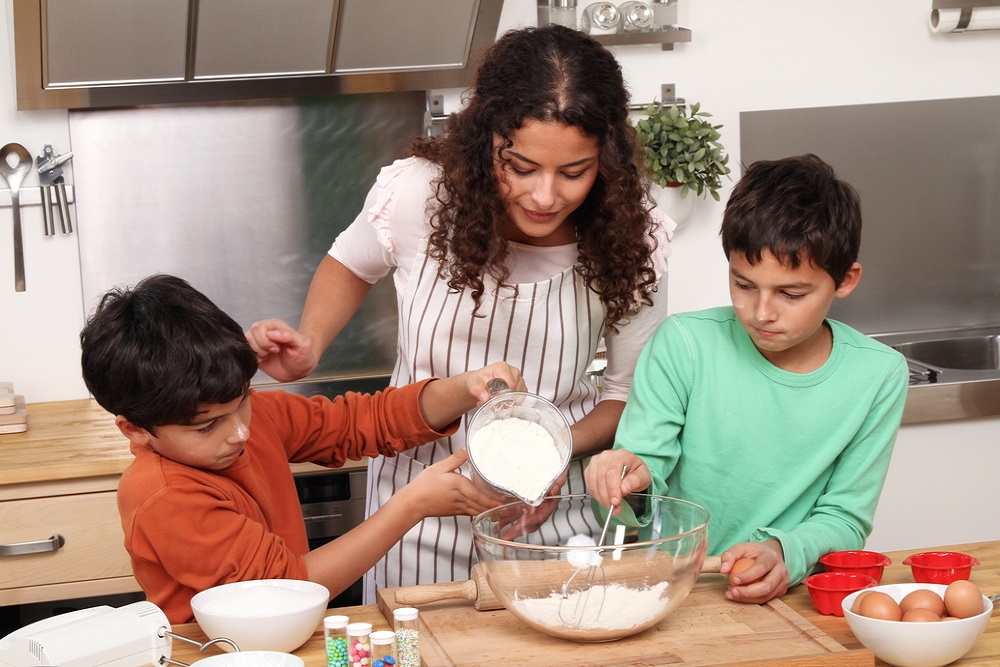
Kids in the Kitchen
Teaching your child to cook is a wonderful way to help them develop important life skills and expand their interests. It also provides a great opportunity for some enjoyable time spent together as a family! However, this recipe for family fun requires a pinch of Patience, a tablespoon of Love and 3 cups of Caution.
Stay In the Kitchen…Stay Alert!
From 2008 to 2010, an estimated 164,500 cooking fires occurred in residential buildings each year throughout the United States, according to the U.S. Fire Administration. The leading cause of these types of kitchen fires was unattended cooking. Unattended cooking means much more than not being present. It can also means not being “present” of your kitchen surroundings. An adult distracted by a child in the kitchen can have hazardous results, so it is important that you stay alert and monitor your child the entire time.
Dress Your Little Chef for Success
Whether cooking solo or with your curious chef, kitchen fire safety is about what you wear as well as what you do. Always dress your little helper in short, close-fitting or tightly-rolled sleeves when working in the kitchen. Avoid loose or oversized clothing. Use only fire retardant aprons and oven mitts. Have any long hair pulled back into a ponytail or covered by a cap and be sure they wear sturdy, closed-toe shoes with non-skid soles.
Respect the Risks
The kitchen can be a source of delectable dishes and appealing aromas, but it can also be a source of danger for those unaware of the risks. Teach your child to treat stoves, oven and microwaves as if they are always hot. Keep your helper’s hands dry to ensure their fingers are not slippery. After running hot water in the sink, be sure to turn the faucet to cold so children do not get burned when washing their hands. Teaching children safe kitchen practices will better ensure their sous chef experiences are injury free and enjoyable.
Assign Age-Appropriate Tasks
Master Chefs did not get that way overnight. They had to start with the basics and build up to more involved tasks as they gain experience. Assign children kitchen duties appropriate to their age, coordination and skill level, as well as provide them the safest tools to create their culinary masterpieces.
Ages 3 to 5
- Grab ingredients out of the refrigerator, but not items in glass or breakable containers.
- Pour liquids into measuring cups or mixing bowls.
- Measure and mix together ingredients in a bowl.
- Wash fruits and vegetables under cold water.
- Cut shapes out of cookie dough or sandwiches with a cookie cutter.
Ages 6 to 8
- Open packages.
- Use a butter knife or spatula to spread frosting, cream cheese, peanut butter or soft cheese.
- Measure ingredients.
- Stir ingredients in mixing bowl.
- Set the table.
Ages 9 to 12
- Help plan the meal.
- Assist in following the recipe.
- Peel and slice vegetables. Be sure to start with a kid-friendly knife made of nylon, ergonomic handle and blunt tip.
- Open cans with a handheld or electric can opener.
- Operate a microwave, but only under adult supervision.
- Use a grater to shred cheese and vegetables.
- Turn stove burners on and off, as well as select the oven temperature. Again, adult supervision is required.
- Make a salad.
Ages 14 and Older
- Operate an oven or stove without an adult present.
- Use a microwave. Make sure children use only microwave-safe containers and never put foil or metal in the microwave.
- Operate the garbage disposal but only when using a safety stuffing tool.
- Drain cooked pasta into a colander.
- Remove a tray of food from the oven.
